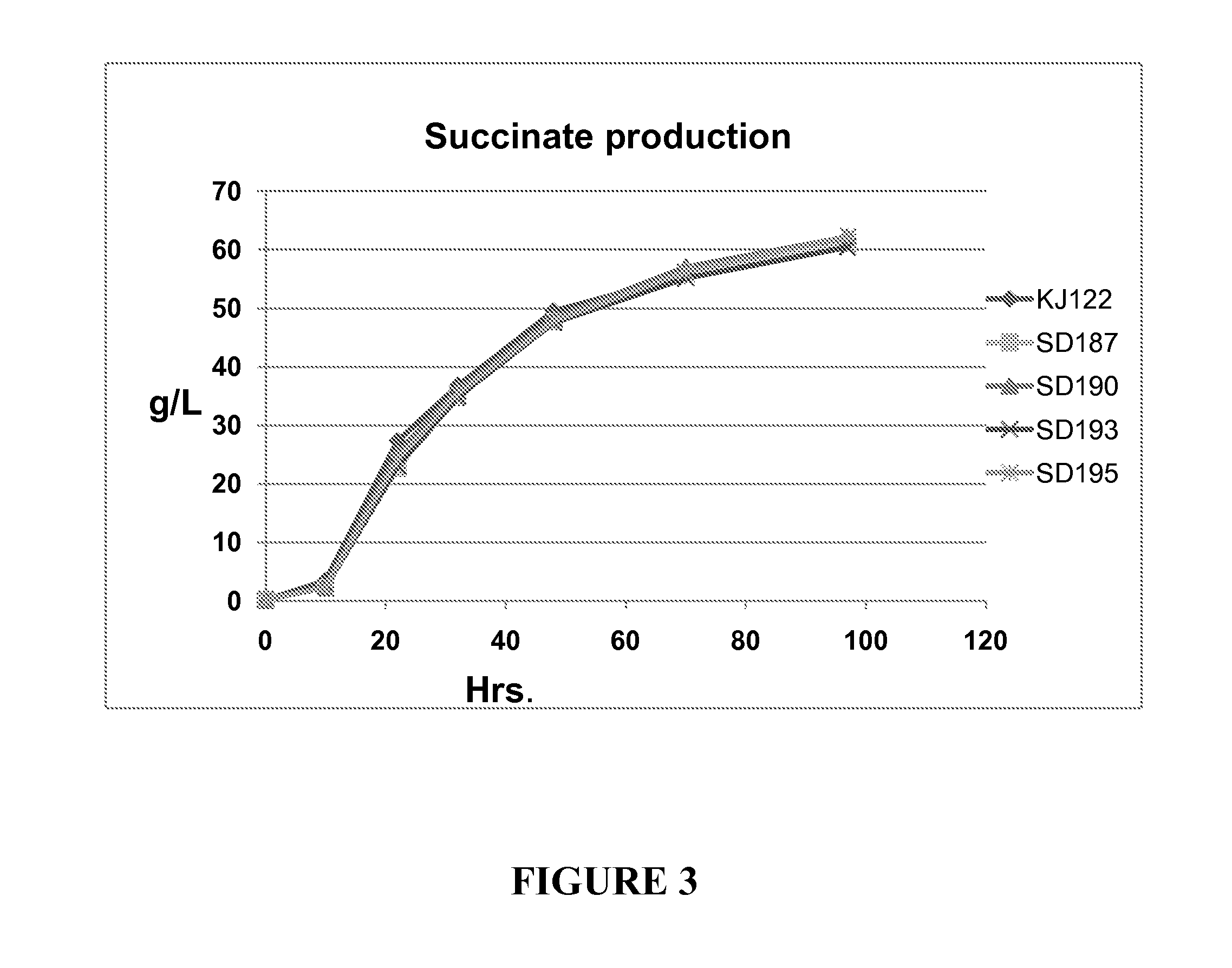Organic acid production in microorganisms by combined reductive and oxidative tricaboxylic acid cylce pathways
a technology of tricaboxylic acid and tricaboxylic acid, which is applied in the direction of microorganisms, enzymology, lysine, etc., can solve the problems of reducing the efficiency of succinic acid production, increasing the cost associated with commercial not being commercially attractive. , to achieve the effect of enhancing the production of succinic acid, enhancing the flow of carbon, and improving the flow of carbon
- Summary
- Abstract
- Description
- Claims
- Application Information
AI Technical Summary
Benefits of technology
Problems solved by technology
Method used
Image
Examples
example 1
Deletion of aceA Gene in KJ122 Strain
[0085]In this invention the aceA gene was deleted from the KJ122 strain. International Patent Applications published under Patent Cooperation Treaty Nos. WO 2008 / 115958 and WO 2010 / 115067 describe the genetic changes that have been introduced in the KJ122 strain. The already existing genetic modifications in KJ122 strain of E. coli include blocking the carbon flow to ethanol, acetate, formate, and lactate. In deleting the aceA gene from KJ122 strain, a two-step homologous recombination process also called a two step gene replacement method, described in detail in the International Patent Application published under Patent Cooperation Treaty with Nos. WO 2008 / 115958 and No. WO 2010 / 115067 and in Thompson et al (2005) was followed. With this method, no antibiotic genes or scar sequences remain on the chromosome after gene deletion.
[0086]In the first recombination, part of the target gene is replaced by a DNA cassette containing a chloramphenicol re...
example 2
Measurement of Glucose Utilization and Succinic Acid Production
[0090]E. coli strains KJ122, SD187, SD190, SD193 and SD195 were grown in AM1 medium containing 10% glucose. AMI medium contains 2.63 g / L (NH4)2HPO4, 0.87 g / L NH4H2PO4, 1.5 mM MgSO4, 1.0 mM betaine, and 1.5 ml / L trace elements. The trace elements are prepared as a 1000× stock and contained the following components: 1.6 g / L FeCl3, 0.2 g / L CoCl2.6H2O, 0.1 g / L CuCl2, 0.2 g / L ZnCl2.4H2O, 0.2 g / L NaMbO4, 0.05 g / L H3BO3, and 0.33 g / L MnCl2.4H2O. The pH of the fermentation broth is maintained at 7.0 with: 1:4 (6 N KOH: 3 M K2CO3) (1.2 N KOH, 2.4 M K2CO3).
[0091]Fermentations were started by streaking on a LB plate a glycerol stock of E. coli strain genetically engineered to produce Succinic acid and stored in the −80° C. freezer. After 16 hours of growth at 37° C., cells from the plate were scraped off and inoculated into sterile glass tubes containing 5 ml of NBS minimal medium containing 2% glucose and grown overnight at 37° C....
example 3
Deletion of the iclR Gene in Strain KJ122
[0094]The iclR gene encodes a repressor of the glyoxylate shunt genes, aceB,A, and K in wild type E. coli strains. Deletion of the iclR gene in KJ122 was accomplished by transduction using the generalized transduction phage P1 vir (Silhavy et al., (1984) Experiments With Gene Fusions, Cold Spring Harbor Laboratory Press, Cold Spring Harbor, N.Y., pp 107-112). The donor strain was JW 3978-2 (ΔiclR785::kan), available from the Coli Genetic Stock Center, Yale University, New Haven, Conn., USA. The recipient strain was KJ122, and the selection was for resistance to kanamycin sulfate at 50 mg / l in rich medium (LB) plates. The resulting strain, named RY847B, was tested in small scale fermentors as described above in Example 2 for succinate production from glucose. Deletion of iclR had almost no effect on initial growth rate or succinate titer, and if anything, the deletion decreased the growth rate and titer slightly. This result was surprising, si...
PUM
| Property | Measurement | Unit |
|---|---|---|
| mass yield | aaaaa | aaaaa |
| mass yield | aaaaa | aaaaa |
| flow rate | aaaaa | aaaaa |
Abstract
Description
Claims
Application Information
 Login to View More
Login to View More - R&D
- Intellectual Property
- Life Sciences
- Materials
- Tech Scout
- Unparalleled Data Quality
- Higher Quality Content
- 60% Fewer Hallucinations
Browse by: Latest US Patents, China's latest patents, Technical Efficacy Thesaurus, Application Domain, Technology Topic, Popular Technical Reports.
© 2025 PatSnap. All rights reserved.Legal|Privacy policy|Modern Slavery Act Transparency Statement|Sitemap|About US| Contact US: help@patsnap.com



